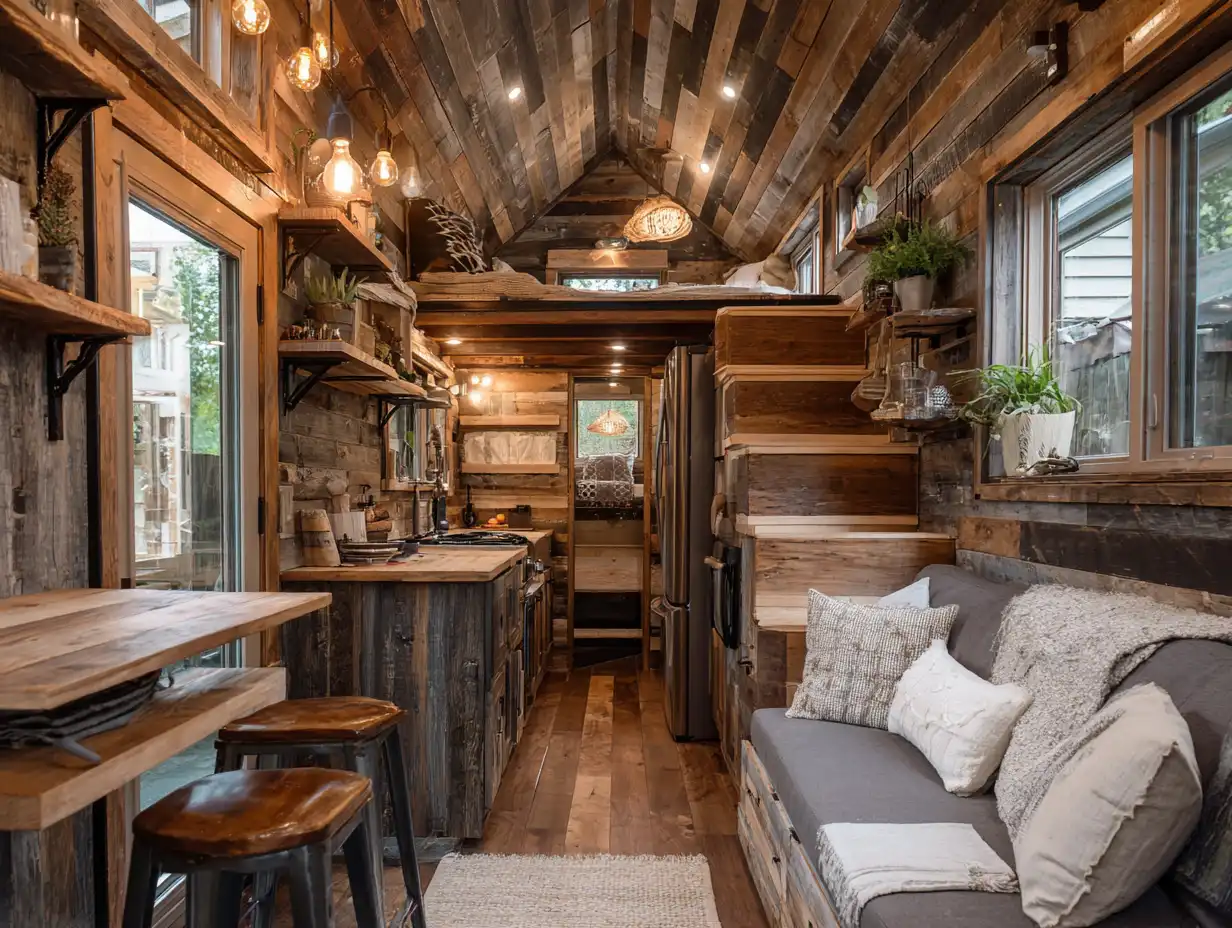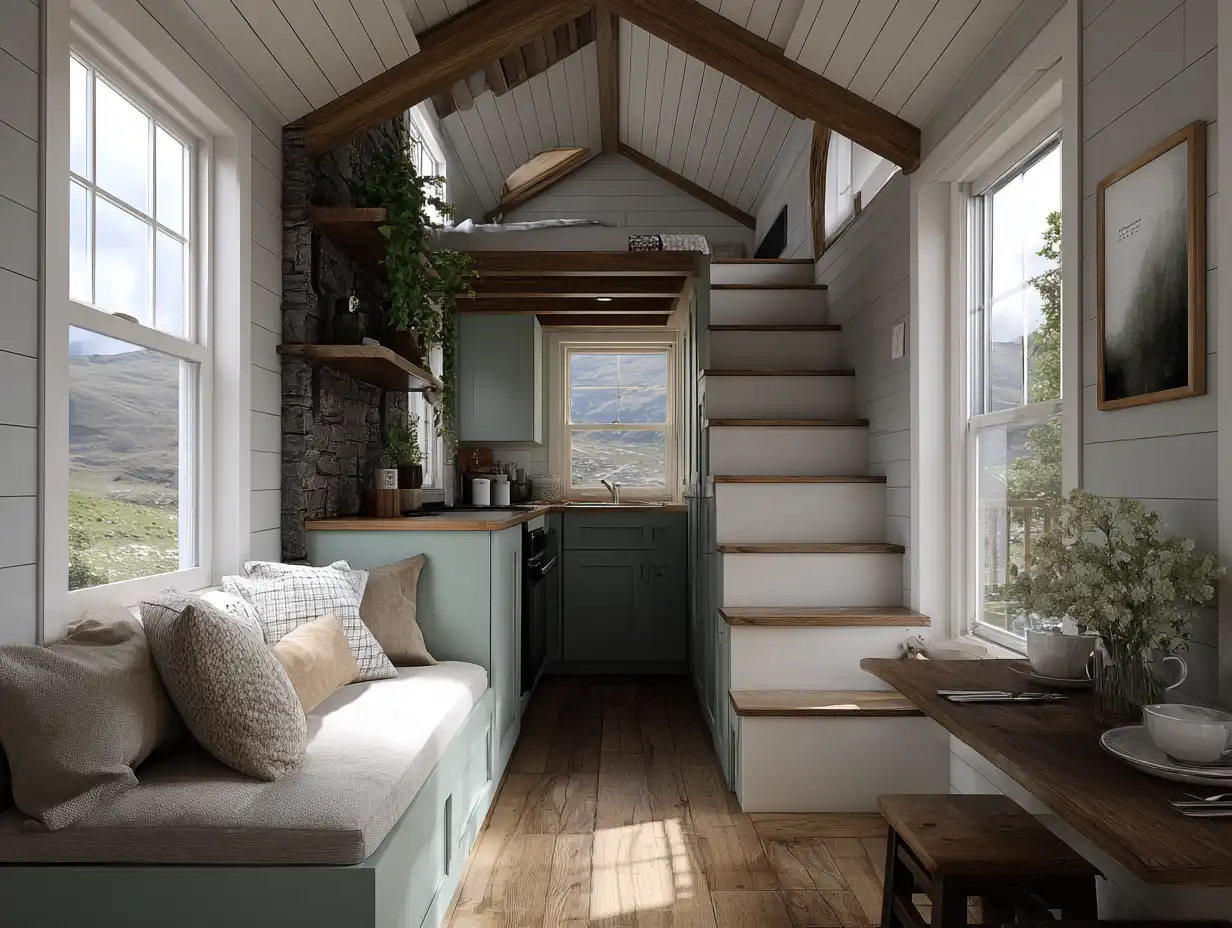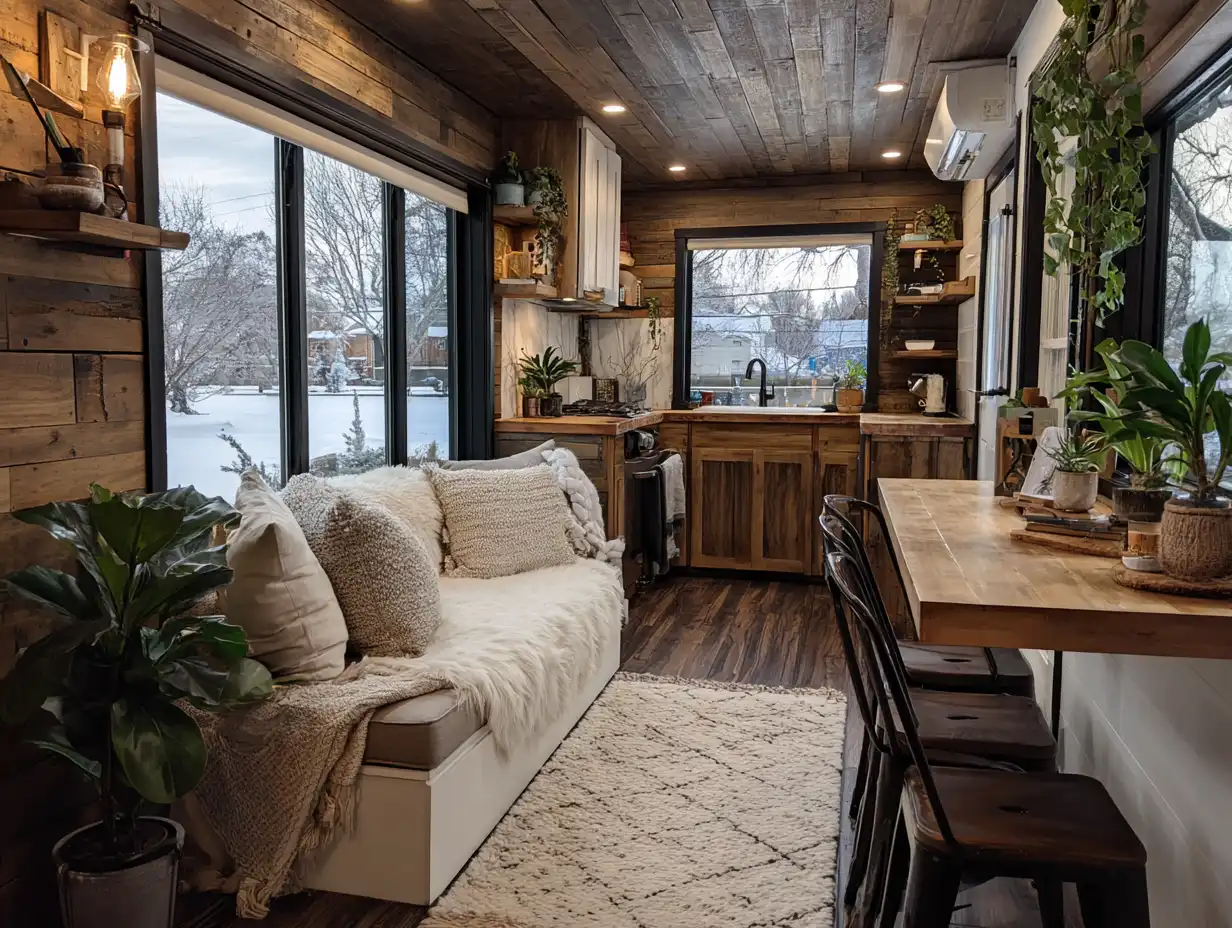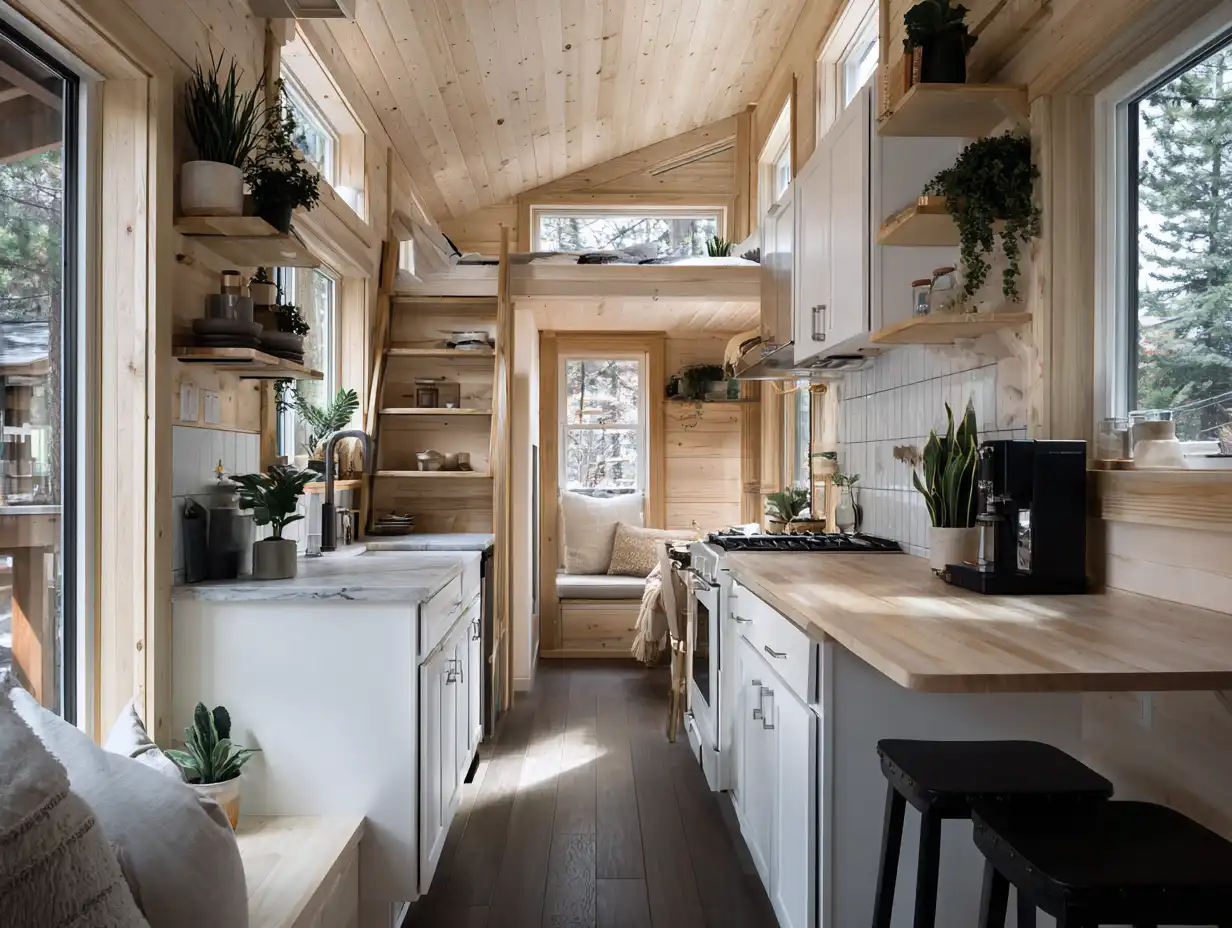Living in a tiny house can be a liberating experience, but it also comes with its own set of challenges, especially when it comes to interior design. We’re drawn to the idea of maximizing every square inch while creating a cozy and functional space that reflects our style. The beauty of tiny house living lies in its simplicity, encouraging us to be intentional about our choices.
In this article, we’ll explore innovative design ideas and clever storage solutions that not only make the most of limited space but also enhance our overall living experience. From multifunctional furniture to creative decor tips, we’ll guide you through the essentials of tiny house interior design, helping us transform our small spaces into stylish and inviting homes. Let’s dive into the world of tiny house design and discover how to make our small spaces feel grand.

Understanding Tiny House Interior Design
Tiny house interior design focuses on maximizing limited space while ensuring functionality and comfort. Effective design can transform cramped areas into stylish living environments that reflect our personal tastes.

Importance of Space Optimization
Space optimization is crucial in tiny house design. Strategic arrangements create the illusion of more space, enhancing comfort. We can achieve this through the following methods:
- Multifunctional Furniture: Use furniture that serves multiple purposes, such as a sofa bed or a dining table that doubles as a workspace.
- Vertical Storage: Incorporate shelves and cabinets that reach the ceiling to utilize vertical space effectively.
- Light Colors: Choose light, neutral colors for walls and furniture to make the space feel larger and brighter.
- Hidden Storage: Integrate storage solutions in furniture, like under-bed storage or ottomans that open, to keep clutter at bay.
- Decluttering: Regularly assess belongings, keeping only essentials to maintain an open and airy atmosphere.
Key Principles of Tiny House Design
- Functional Layout: Plan layouts that emphasize flow, ensuring easy movement and accessibility throughout the space.
- Natural Light: Utilize windows and skylights to invite natural light, enhancing the sense of space and warmth.
- Integrated Design: Create cohesion by integrating design elements, from color palettes to materials, for a unified look.
- Personal Touches: Incorporate personal items and decor that reflect our style, making the space feel uniquely ours.
- Sustainability: Embrace eco-friendly materials and energy-efficient appliances to support a sustainable lifestyle while living in a tiny home.
Popular Tiny House Styles
Tiny houses offer diverse design styles, each providing a unique character while maximizing space. Below, we explore three popular tiny house styles.

Modern Minimalism
Modern minimalism emphasizes simplicity and functionality. We focus on clean lines and open spaces, often opting for neutral color palettes like whites and grays. Functional furniture plays a key role; pieces such as a fold-out table or a Murphy bed provide essential versatility. Natural light enhances the airy feel, promoting an uncluttered environment. Many modern minimalist tiny houses include large windows and skylights to create the illusion of greater space.
Rustic Charm
Rustic charm combines warmth and coziness, often featuring natural materials like wood and stone. We embrace exposed beams, reclaimed wood accents, and vintage furnishings that evoke a sense of comfort. Earthy tones such as browns and greens complement this style, making interiors inviting. Cozy nooks, such as window seats or built-in bookshelves, add charm while optimizing space. Accessories like handmade textiles and antique décor enhance the rustic aesthetic, creating a welcoming atmosphere.
Industrial Vibes
Industrial vibes feature an urban aesthetic characterized by raw materials and an unfinished look. We incorporate elements like exposed brick walls, concrete floors, and metal accents to create a bold statement. Open layouts foster a sense of spaciousness, while oversized furniture makes a striking impression. Features such as large, factory-style windows provide ample natural light. We often use vintage or repurposed items as decor, further solidifying the industrial theme and adding personality to the tiny house environment.
Essential Elements of Tiny House Interiors
In tiny house interiors, we focus on maximizing space while maintaining style and functionality. Several key elements play a crucial role in creating comfortable and efficient living areas.

Multifunctional Furniture
Multifunctional furniture serves an essential purpose in tiny houses. We incorporate pieces that offer multiple uses, such as sofas that convert into beds, coffee tables with storage compartments, and foldable dining tables. By selecting furniture that adapts to our needs, we free up valuable floor space and enhance the overall utility of the area. Examples of multifunctional furniture include ottomans that double as storage bins and Murphy beds that fold into the wall when not in use.
Smart Storage Solutions
Smart storage solutions are vital for keeping tiny house interiors organized. We utilize vertical space by installing shelves, wall-mounted racks, and hooks. Under-bed storage can hold seasonal items or rarely-used supplies. We also take advantage of nooks and crannies, employing cabinetry that fits perfectly beneath stairs or in corners. Creative storage solutions might include built-in benches with hidden compartments or furniture that incorporates pull-out drawers.
Natural Light Utilization
Natural light utilization enhances the ambiance of tiny houses. We maximize windows and skylights to create an airy, open feel while reducing reliance on artificial lighting. Light-colored curtains or blinds allow daylight to filter through without sacrificing privacy, and reflective surfaces can amplify brightness. We also consider using glass doors for direct outdoor access, blurring the lines between interior and exterior spaces. By implementing these strategies, we foster a warm, inviting atmosphere that brings our tiny home to life.
Color Schemes and Materials
Color schemes and materials play a crucial role in tiny house interior design. Choosing the right palette and sustainable materials enhances aesthetics while optimizing the limited space.

Trending Color Palettes
Trending color palettes reflect the desire for open, airy interiors. Light colors, such as soft pastels and whites, create an illusion of space and enhance natural light. We often see the following color combinations:
- Soft Neutrals: Shades like beige, ivory, and light gray provide a calming backdrop that complements various decor styles.
- Earthy Tones: Colors such as terracotta, olive green, and muted browns create warmth and a connection to nature, especially in rustic designs.
- Accent Colors: Bold hues like navy blue, forest green, or mustard yellow introduce personality and can be used sparingly on accent walls or furniture.
Using these trending palettes contributes to a cohesive and inviting atmosphere in tiny spaces.
Sustainable Material Choices
Sustainable materials support eco-friendly living while improving the overall design of tiny homes. We prioritize the following materials in our designs:
- Reclaimed Wood: Utilizing reclaimed wood for flooring or furniture adds character while reducing waste.
- Bamboo: As a fast-growing, renewable resource, bamboo serves as flooring, cabinetry, or decor, providing durability and a modern aesthetic.
- Recycled Metals: Incorporating recycled metals in accents or fixtures enhances the industrial vibe while promoting sustainability.
- Natural Fibers: Materials like organic cotton, linen, or jute for textiles add softness and warmth without harmful chemicals.
These sustainable choices align with environmentally conscious living, appealing to many tiny house owners.
Creating a Cozy Atmosphere
We create a cozy atmosphere in our tiny house through thoughtful design elements that promote comfort and warmth. Focusing on textures, fabrics, and personal touches enhances our living experience and makes our small space feel inviting.

Textures and Fabrics
Incorporating various textures and fabrics is crucial for adding depth and warmth to our interiors. We use soft textiles, like plush throws and textured cushions, to create a welcoming environment. Natural fabrics, such as cotton and linen, provide comfort while maintaining a lightweight feel. Layering textiles on furniture, such as upholstered chairs or a simple bed frame, softens the overall look. We also opt for area rugs to anchor spaces and define areas, which help create distinct zones in our tiny homes. Mixing textures, like combining smooth metal with soft wool or rough wood, visually enriches our interiors while making them feel more inviting.
Personal Touches and Decor
We emphasize personal touches and decor to reflect our individual styles and create a unique atmosphere. Displaying family photographs, artwork, or handmade crafts adds character to our tiny homes. We select decor items that resonate with us, enhancing our space’s warmth and personality. Additionally, using plants or fresh flowers introduces life and color into our interiors, promoting a sense of tranquility. We arrange decor thoughtfully, ensuring that it complements our overall design without overwhelming the limited space. Striking a balance between style and functionality contributes to an inviting environment that feels like home.
Conclusion
Tiny house interior design offers unique opportunities to create stylish, functional spaces that reflect our personal tastes. By applying key principles like maximizing space, incorporating multifunctional furniture, and utilizing vertical storage, we transform limited square footage into inviting homes.
We explore popular styles—Modern Minimalism, Rustic Charm, and Industrial Vibes—each presenting distinct characteristics and design elements that enhance comfort. Our focus on essential elements, including light colors and smart storage solutions, lays the foundation for a bright, airy atmosphere that promotes well-being.
Sustainable materials play a vital role in our design choices, enabling us to achieve aesthetic appeal while supporting eco-friendly living. Incorporating personal touches and various textures fosters warmth and individuality, ensuring our tiny homes feel welcoming and comfortable.
Ultimately, embracing these strategies allows us to thrive in smaller spaces, achieving a balance between elegance and practicality in our tiny house interiors.
- aesthetic small home designs
- compact living space solutions
- creative tiny house ideas
- customizable tiny home designs
- eco-friendly tiny house designs
- efficient tiny house layouts
- functional small space design
- innovative tiny house decor
- minimalist tiny house interiors
- modern tiny house interiors
- small space living ideas
- space optimization for tiny homes
- space-saving furniture for tiny homes
- stylish tiny home interiors
- tiny home bedroom designs
- tiny home design inspiration
- tiny house interior decor tips
- tiny house interior design
- tiny house kitchen ideas
- tiny house living ideas















Leave a comment